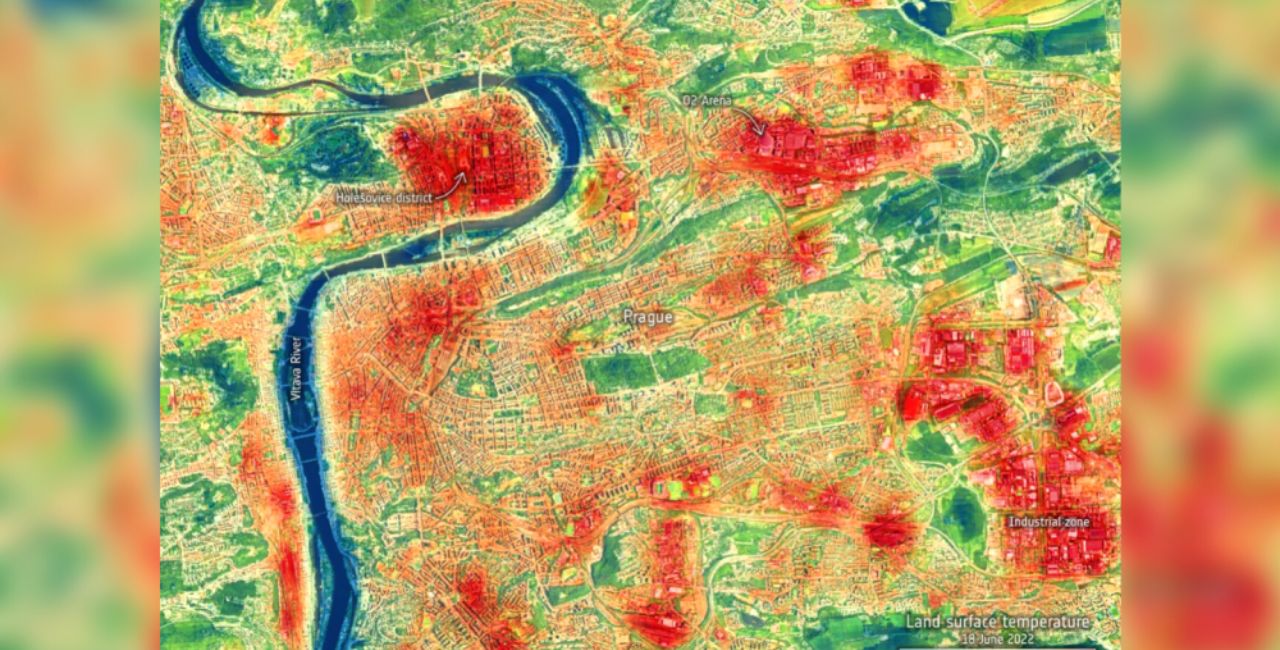Picture From Space Shows a Red-Hot Holešovice. ‘Solar Panels Could Help,’ Suggests Expert

Holešovice, the surroundings of the O2 Arena, and the industrial zone in Šterboholy. These spots glow red in the temperature image from June 18th taken from the International Space Station.
The sun heats surfaces to more than 45 degrees. What exactly does the picture show? What are its pitfalls? How can photovoltaic panels improve the situation? Landscape planning specialist Michael Pondelíček from the Prague Institute of Planning and Development answered all this and more.
Could you describe what the June 18 image taken from the International Space Station shows?
It shows what the temperature conditions are in Prague in instantaneous temperatures. So it shows the current temperatures in the given places. Since it was a warm day, we can therefore conclude that the image shows us an instantaneous temperature map. It is a simple idea of how the city is doing thermally on a normal day.
We can also see white or dark red places on it where the temperature is around 50 degrees Celsius. And also the blue or green areas which are cooler and where the temperature drops to 30 degrees Celsius.
Yes. The main one is the cooling corridor in Prague, which is the Vltava and its surroundings, which operates day and night. It is also colder because water is released from the dam, and thus the river cools the capital very pleasantly.
The second thing that can be seen there are larger areas of green, i.e. vegetation, such as Stromovka, Petřín or Vítkov. The large Olšan
cemetery can also be seen very nicely there, which is a cooling gem for a certain part of Prague.
If the picture, as you say, shows the temperature of the surface at one particular moment, we can also see the temperature of many tin roofs or concrete places. Are these probably the warmest places?
Yes, but we must not forget that it can be deceiving. Airflow and traffic density on that day also play a role. Both create flows and changes in how the air masses move over Prague. So what is sensed is sensed, but it can be distorted by the ambient air temperature.
According to the picture, Holešovice is one of the warmest parts of the city. Can you say why that is? Do metal roofs play a role?
Roofs can cause something, but there are quite a few green roofs in Holešovice. It is more due to the structure and ventilation of the urban district. We have to take into account that Holešovice is somewhat flat, at the very bottom of the Vltava basin and is poorly ventilated. This is – I would say – one of the main reasons why the streets of Holešovice can get warm during tropical days, when temperatures are over 30 degrees for several days in a row.
What steps would help the measurement to be better in the future, so that the surfaces are not as warm as the map shows?
At first, there are relatively simple measures that can cool objects. If it is, for example, a tin roof, we can use a paint that reflects sunlight, such as white or silver. It won’t absorb solar energy as much, and that’s already quite a significant cooling.
And then, of course, work with other things. Green roofs have their meaning, although it may not seem so. They do not work down in the
street corridor, but as far as cooling the microclimate above the roofs of buildings is concerned, it is important. The flight of birds or insects is at a certain point in danger because some roofs are 55 degrees, but we also measured a roof that was 85. And these are temperatures that are not acceptable for anything alive.
So increase the reflectivity, reduce the temperature with a roof garden or greenery. Currently, however, the placement of photovoltaic panels on roofs is also being considered. It absorbs the sun’s energy and produces electricity, thereby cooling that photovoltaic panel.
So, for example, Holešovice or the O2 arena, which is also dark red in the picture, could be an ideal place to place photovoltaic panels?
Pretty sure in certain south-facing locations. Of course, we will meet the demands of the preservationists, but it is necessary to realize that at a time when there is a gas and oil crisis and a war in Ukraine, it would be appropriate to think about whether it is necessary to stick to the protection zone of the monument reserve in Prague in focus on keeping everything stylishly clean. Today there are also photovoltaic panels in the color of the roof covering. You can’t tell from a distance.
Do photovoltaic panels on roofs already work somewhere in Prague? Does Prague have any such project?
Certainly. One of the first was at the Ministry of the Environment building. And more of those panels were placed. I suspect that they are on some CTU buildings in Dejvice. I think that some other buildings on the outskirts of Prague are already equipped in this way.
What does the term heat island actually mean?
These are the places where, especially on tropical days, temperatures are concentrated and steadily rise. Places that do not have a microclimate to match the sunlight. The heat island is best seen in evening and night shots. What the city shines after dark is the interesting part. That’s all sheet metal and concrete.
For the heat island, they look at how much greenery and water features there are in the streets, but the night temperatures also play a relatively large role.
On a heat island, especially for humans, it’s annoying that you can’t ventilate more or less during those tropical days. People don’t sleep. The city basically doesn’t have time to cool down in those places. And if people install air conditioners, we might end up like in Japan.
On some days it is forbidden to use appliances there because the energy consumption for the air conditioners is huge. They are no longer able to exist without it. The city is already so hot that it’s hard to walk outside the buildings.
Are the places in the mentioned image from the International Space Station similar to those heat islands?
Already in 2020, the Institute of Planning and Development developed a kind of map of heat islands according to foreign methodologies. And one of its outputs is on the Prague geoportal. You can see which places are really warm and which are not.
According to the map of heat islands, can you tell which place is the warmest for living in Prague, and which is the coldest?
The surfaces themselves play a significant role. But a very warm area from the point of view of geographical location, poorly ventilated is the one called Hradební corzo, i.e. old Prague behind the walls, the Old Town, a heritage reserve. It is definitely a heat island.
And vice versa, the cooler place where the heat island is not at all or not so pronounced?
Prague has a prevailing westerly to south-westerly flow. Therefore, the edges of Prague above the level of the Vltava basin, such as Pankrác, are ventilated in a relatively good way. Even though it is a housing estate and there are skyscrapers, this part of Prague is relatively well ventilated. Or also Stodůlky.
Support Prague Morning!
We are proud to provide our readers from around the world with independent, and unbiased news for free.
Our dedicated team supports the local community, foreign residents and visitors of all nationalities through our website, social media and newsletter.
We appreciate that not everyone can afford to pay for our services but if you are able to, we ask you to support Prague Morning by making a contribution – no matter how small 🙂 .



